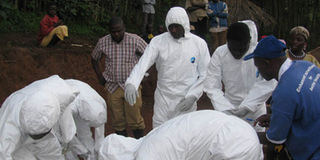Why is Uganda prone to infectious diseases?

Epidemiologists experts bury Mr Nathan Biryamubaho on Saturday. He died of Marburg virus. The relatives were not allowed to participate in the burial ceremony because they did not have protective gear. Photo by Robert Muhereza.
What you need to know:
With one epidemic after another being reported, there is obvious fear in the country. Though the viruses of the recent outbreak of Marburg have no treatment yet, medics says victims can recover once they have been detected and attended to in time.
Barely a month after Uganda was declared Ebola free, another virulent hemorrhagic viral infection – Marburg, a disease caused by a sister virus to Ebola is back on the scene.
Such infectious diseases are emerging and occurring more frequently in Uganda today.
Globally, the World Health Organisation (WHO) says the number of these diseases has quadrupled in the last half century and is one of the biggest threats to public health.
In its annual world health report in 2007, WHO reported that infectious diseases are not only spreading faster, they also appear to be emerging more quickly than ever before.
“Since the 1970s, newly emerging diseases have been identified at the unprecedented rate of one or more per year. There are now nearly 40 diseases that were unknown a generation, says WHO.
It further shows these emerging viral diseases including Ebola, Marburg haemorrhagic fever and Nipah virus are a threat to global public health security and require containment at their source due to their acute nature and resulting illness and mortality.
But why is Uganda more prone to these diseases now? Public health experts say human activity is largely to blame. With more people encroaching on wildlife habitat, with animals are hosts to these viruses, chances of transmission to humans is high.
Health ministry officials say these outbreaks will not stop as long as human beings continue to encroach on wildlife habitats.
The commissioner national disease control Dr Dennis Lwamafa explained that most of these diseases revolve around humans, environment and zoonotic factors.
“And this will continue so long as man continues feeding on wildlife animals or encroach on their habitats for human activities. We are even likely to see more new emerging diseases.”
Forest encroachers at risk
Ebola and Marburg haemorrhagic fevers outbreaks are said to occur in places near forests and forest reserves that have been encroached on by human activity such as cutting trees, leaving the place open for wildlife to freely interface with man.
Dr Lwamafa explains that where optimal condition exists for direct interface of man and wildlife, there will be transmission of diseases which are not typically human diseases, moving from the wild animal kingdom to human beings through the environment.
“The extent to which man continually invades the environment, the deeper he moves into the forest areas, the more likely he is going to encounter organisms, viruses, and other biological agents that are were normally preserves of animal kingdom. These will have a direct impact on the human life inform of contagious disease such as Ebola and Marburg.”
Reports from the Ministry of Health from ecological studies done in the areas where these outbreaks have occurred indicate direct interface between wildlife and human animals especially monkeys and bats.
“Where we have had Ebola, the monkeys were coming into people’s homes and sharing food, while the bats were even staying in some houses after their habitats were destroyed and bushes cleared for farming in the cases of Luweero, Kibaale, Bundibugyo among other areas.” Dr Lwamafa says.
According to Dr Joaquim Saweka, WHO’s country representative, diseases classified under zoonotic originate from animals to human beings through secretions, fluids or shared food.
“Increased exposure of human beings to saliva, secretions, urine and other fluids of virus hosts which are bats and monkeys is more likely to cause disease that are harbored by wild animals,” Dr Saweka said.
Acts of terrorism?
Dr Myers Lugemwa, a specialist in international health holds a totally different view arguing that before conclusions are drawn, the government should investigate why these outbreaks occur ahead of international events and near national parks.
He says it is possible that the disease outbreaks could be acts of bio-terrorism aimed at terrorising and crippling the rather booming tourism sector in the country.
“Uganda is not the only country with monkeys and fruit bats in forests. Uganda is not the only place where people eat monkey meat. We just need to think outside the box and it doesn’t cost us a lot to investigate this issue,” Dr Lugemwa said.
He argues that these highly infectious disease outbreaks have not occurred in all areas around forests or other countries that have more monkeys, bats and forests being encroached on.
“It is not a coincidence that the recent Ebola epidemic broke out just a few months before Uganda’s golden jubilee celebrations.
Early 2010, US nuclear experts, visited the Ministry of Agriculture and Uganda Virus Research Institute (UVRI) laboratories in Entebbe to assess the next-generation security threats, among them bio-terrorism.
Dr Lugemwa recommends more research to investigate the correlation between international events and disease outbreaks.




